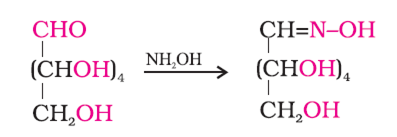Sponsor Area
Biomolecules
Glucose or sucrose are soluble in water but cyclohexane or benzene (simple six membered ring compounds) are insoluble in water. Explain.
Molecules which have polar nature are capable to form hydrogen bond are generally soluble in water. In sucrose and glucose hydroxyl groups are present, which is polar in nature. Therefore, they are involved in intermolecular hydrogen bonding with water molecules, so these compounds are readily soluble in water. On other hand benzene and cyclohexane are hydrocarbons. They do not have any polar group so they cannot make hydrogen bonds with water.
What are the expected products of hydrolysed of lactose?
Upon hydrolysis, lactose gives equivalent amounts of D(+) glucose and D(+) galactose.
How do you explain the absence of aldehyde group in the penta acetate of D-glucose?
Glucose reacts with hydroxylamine to form an oxime. where as, the penta acetate of glucose does not react with hydroxyl amine indicating the absence of free CHO group.
The melting points and solubility of water of amino acids are generally higher than that of the corresponding halo acids. Explain.
Amino acids are dipolar in nature (+NH3-CHR-COO-) and have strong dipolar interaction. Amino acids have amino (basic) group and carboxylic (acidic) group. A proton which comes from carboxylic group is accepted by amino group. Thus amino acid exists in the form of Zwitter ion.

Due to this ionic form, amino acids become crystalline solids and due to this salt like structure, show higher melting point.
Sponsor Area
Mock Test Series
Mock Test Series





